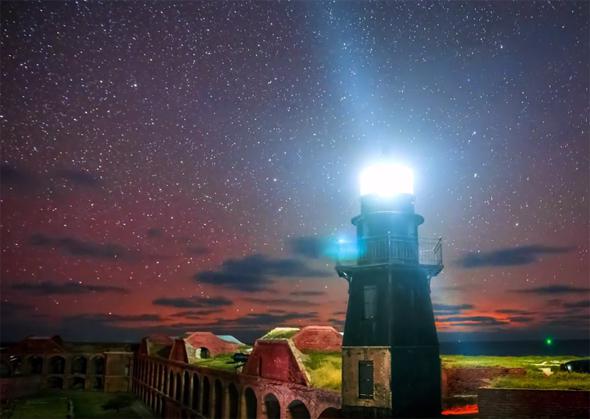How have I never heard of Dry Tortugas National Park until now? It’s a little more than 100 kilometers west of Key West, Florida, in the Gulf of Mexico. It’s pretty remote, accessible only by boat or seaplane, and has an interesting history.
It’s the location of Fort Jefferson, a huge brick fortress that was constructed over a period of 30 years in the 19th century but never completed. It was built to protect the busy waters at the entrance to the Gulf and was also a prison—Samuel Mudd was sent there, convicted for conspiring with John Wilkes Booth in the assassination of Lincoln.
It was a miserable place to be incarcerated, with terrible conditions. When I read that I was astounded; that’s bizarre given how gorgeous the waters are there: crystal clear, with coral and abundant fish. Ironically, it’s a tourist destination now known for its beauty.
And it’s even more bizarre when you think about how beautiful the skies are there. With no land except a few small sandy islands all the way out to the horizon, the skies there are fiercely dark at night, and the stars shine with brilliant intensity.
I learned all this when photographer Harun Mehmedinovic sent me a note about his newest time-lapse video, “Tortugas Rock,” which is a stunning display of just how spectacular this site is:
Whoa. Mehmedinovic employed a variety of effects to enhance the scenes, including stacking frames to create star trails that show the motion of the stars in the sky, reflecting the Earth’s rotation on its axis. Because it’s so far south, from this location the Milky Way gets higher overhead than it does from most of the U.S. and really dominates the video when it’s visible.
I also really like the music. It’s called “Escape Velocity,” and was written by Terry Devine-King. You can find more of his work online.
Mehmedinovic made this as part of the Skyglow Project, an effort he’s undertaking with fellow photographer Gavin Heffernan to visit remote locations and document the skies there. Their goal is to underscore the issue of light pollution and the damage it causes. I support this effort.
Watching this video and reading about the park, I have to add this place to my ever-growing list of spots on Earth I wish to see. It’s no coincidence that many of these are remote, difficult to access, and not well known. All of these are ingredients that add up to a dark sky and spectacular viewing at night. I sometimes wonder if there are enough nights to visit them all.
I’ve written about some of Mehmedinovic’s work before; check these out:
